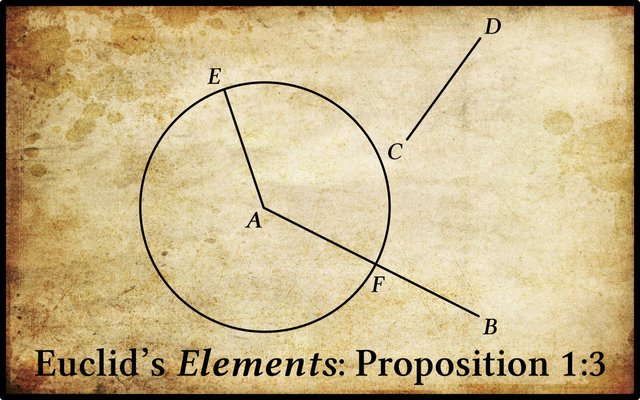Euclid’s Proposition 1:3

Book 1 of Euclid’s Elements opens with three constructions. The third of these demonstrates how to cut off from the longer of two given line segments a segment equal in length to the shorter of the two (Fitzpatrick 9):
| Greek | English |
|---|---|
| Δύο δοθεισῶν εὐθειῶν ἀνίσων ἀπὸ τῆς μείζονος τῇ ἐλάσσονι ἴσην εὐθεῖαν ἀφελεῖν. | For two given unequal straight-lines, to cut off from the greater a straight-line equal to the lesser. |
This construction is carried out using the technique we learned in the previous construction, Proposition 1:2: How to construct a line segment which is equal in length to a given line segment and which has a given point as one of its endpoints. In this case, the shorter line segment is the given line segment, and one of the endpoints of the longer line segment is the given point.
This proposition and its demonstration may be expressed in modern language as follows:

Unlike the previous proposition, which is used only once, this particular proposition is used in every one of the geometrical books of the Elements: Books 1–4, 6 and 11–13. In fact, it is used more often than any other construction.
In his Commentary Proclus describes several different cases of this construction (Morrow 179 ff), but Thomas Heath criticizes him for this:
Proclus contrives to make a number of “cases” out of this proposition also, and gives as many as eight figures. But he only produces this variety by practically incorporating the construction of the preceding proposition, instead of assuming it as we are entitled to do. If Prop. 2 is assumed, there is really only one “case” of the present proposition, for Potts’ distinction between two cases according to the particular extremity of the straight line from which the given length has to be cut off scarcely seems to be worth making. ―Heath 247
And that’s a good place to stop.
References
- Ernst Ferdinand August, Euclidis Elementa, Part 1, Theodor Trautwein, Berlin (1826)
- Henry Billingsley (translator), The Elements of Geometrie of the Most Auncient Philosopher Evclide of Megara, John Day, London (1582)
- Oliver Byrne, The First Six Books of The Elements of Euclid in Which Coloured Diagrams and Symbols Are Used Instead of Letters for the Greater Ease of Learners, William Pickering, London (1847)
- Richard Fitzpatrick (translator), Euclid’s Elements of Geometry, University of Texas at Austin, Austin, TX (2008)
- Thomas Little Heath (translator & editor), The Thirteen Books of Euclid’s Elements, Second Edition, Dover Publications, New York (1956)
- Johan Ludvig Heiberg, Heinrich Menge, Euclidis Elementa edidit et Latine interpretatus est I. L. Heiberg, Volumes 1-5, B G Teubner Verlag, Leipzig (1883-1888)
- Glenn Raymond Morrow (translator), Proclus: A Commentary on the First Book of Euclid’s Elements, Princeton University Press, Princeton, NJ (1970)
- François Peyrard, Les Œuvres d’Euclide, en Grec, en Latin et en Français, Volumes 1-3, Charles-Frobert Patris, Paris (1814, 1816, 1818)
- Thomas Taylor, The Philosophical and Mathematical Commentaries of Proclus on the First Book of Euclid’s Elements, Volume 1, Volume 2, London (1792)
Online Resources
